feature
Mesozoic Measurement
Three-dimensional learning for young students
Science and Children—September/October 2021 (Volume 59, Issue 1)
By Laura B. Schneider and Angelique Kelly

Next Generation Science Standards (NGSS) three-dimensional learning is valuable for all students regardless of age. The NGSS integrate disciplinary core ideas, science and engineering practices, and crosscutting concepts, adding rigor to science teaching and learning. Though NGSS performance expectations begin at the kindergarten level, students can be introduced to the three dimensions prior to kindergarten. All students, including young learners, can actively engage in science and engineering practices, and everyone can benefit from learning crosscutting concepts—themes that bridge the science disciplines. Having students engage with crosscutting concepts is important because when taught in an explicit manner, crosscutting concepts “enable less privileged students, most from non-dominant groups, to make connections among big ideas that cut across science disciplines” (NGSS Lead States 2013 Appendix D, p. 6).
This article describes using a 5E (Engagement, Exploration, Explanation, Elaboration, Evaluation) lesson on dinosaurs to engage three- to five-year-old students in three-dimensional learning. The lesson explores the research questions: How long were the dinosaurs from head to tail? How did their length compare to our height?
Students use the science practices of mathematical and computational thinking and analyzing and interpreting data while they make predictions. They learn about patterns as they record data and compare lengths of dinosaurs. They also learn about adaptation and the crosscutting concept of scale. This lesson teaches the mathematical construct of nonstandard measurement, meaning measuring with objects not traditionally used as measurement tools. Nonstandard measurement can be a beginning foray in scale since using measurement is a first step to understanding scale (Ashbrook 2014).
Dinosaurs were selected due to our students’ inherent interest and because “interest is an important factor in children’s involvement in learning science” (NRC 2012, p. 286). Dinosaurs also varied greatly in length, making them useful for discussing scale.
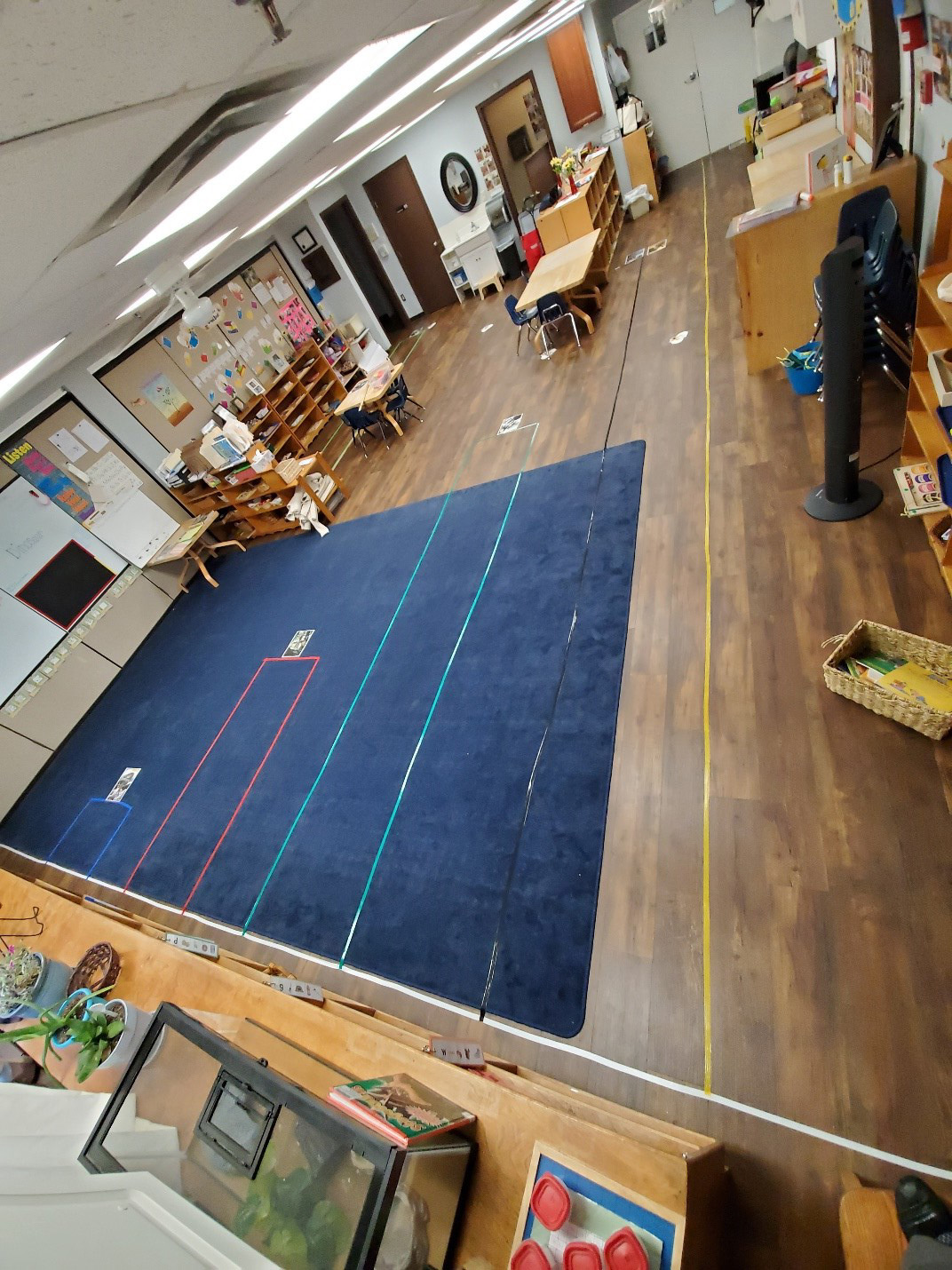
Day 1: Engagement
In circle time, students shared their knowledge of dinosaurs as a formative assessment. Our students held the common misconception that all dinosaurs were large (Person 2018). They understood that dinosaurs were no longer alive and that scientists study their bones and teeth. They had some background on what the environment was like when dinosaurs were alive from pictures they had seen in books with large plants. When asked if any dinosaurs were shorter, many of our students shared that baby dinosaurs are small, but they still thought of all adult dinosaurs as large. Ideas about adults being large compared to juveniles probably stemmed from our studies of life cycles. Only one student said dinosaurs could be tiny. He held out his hand and said some dinosaurs could “sit in your hand.” With additional questioning, it became apparent that his misconception stemmed from thinking toy dinosaurs were life-sized.
A second formative assessment asked students to think about the length of adult dinosaurs and sort them from longest to shortest. We included plastic figures from longest to shortest: Apatosaurus, Tyrannosaurus, Stegosaurus, Triceratops, Pachycephalosaurus, and Velociraptor. When selecting figures, it is important to select ones that have proper relative size so as to not cause any misconceptions. As an alternative, images of dinosaurs could be printed and used in lieu of plastic figures. Students were aware that Tyrannosaurus and Apatosaurus were extremely large, but they incorrectly thought of a Velociraptor as one of the large dinosaurs. They had some difficulty with this task since they thought of dinosaurs as all very large.
We read National Geographic Kids: Ultimate Dinopedia to learn about the dinosaurs discussed in the sorting activity as well as the Microraptor (Lessem 2017). The Microraptor was added to address the misconception that all dinosaurs were large. This reading gave learners background knowledge on each dinosaur, such as diet and special adaptations as well as lengths. While we did not discuss the term natural selection, students were learning about adaptation when they compared and contrasted which dinosaurs had similar evolutionary features such as large horns, armored plates, and long necks. On each page of the book, there is a silhouette of the dinosaur next to a human, which we pointed out to start students thinking about comparing lengths.
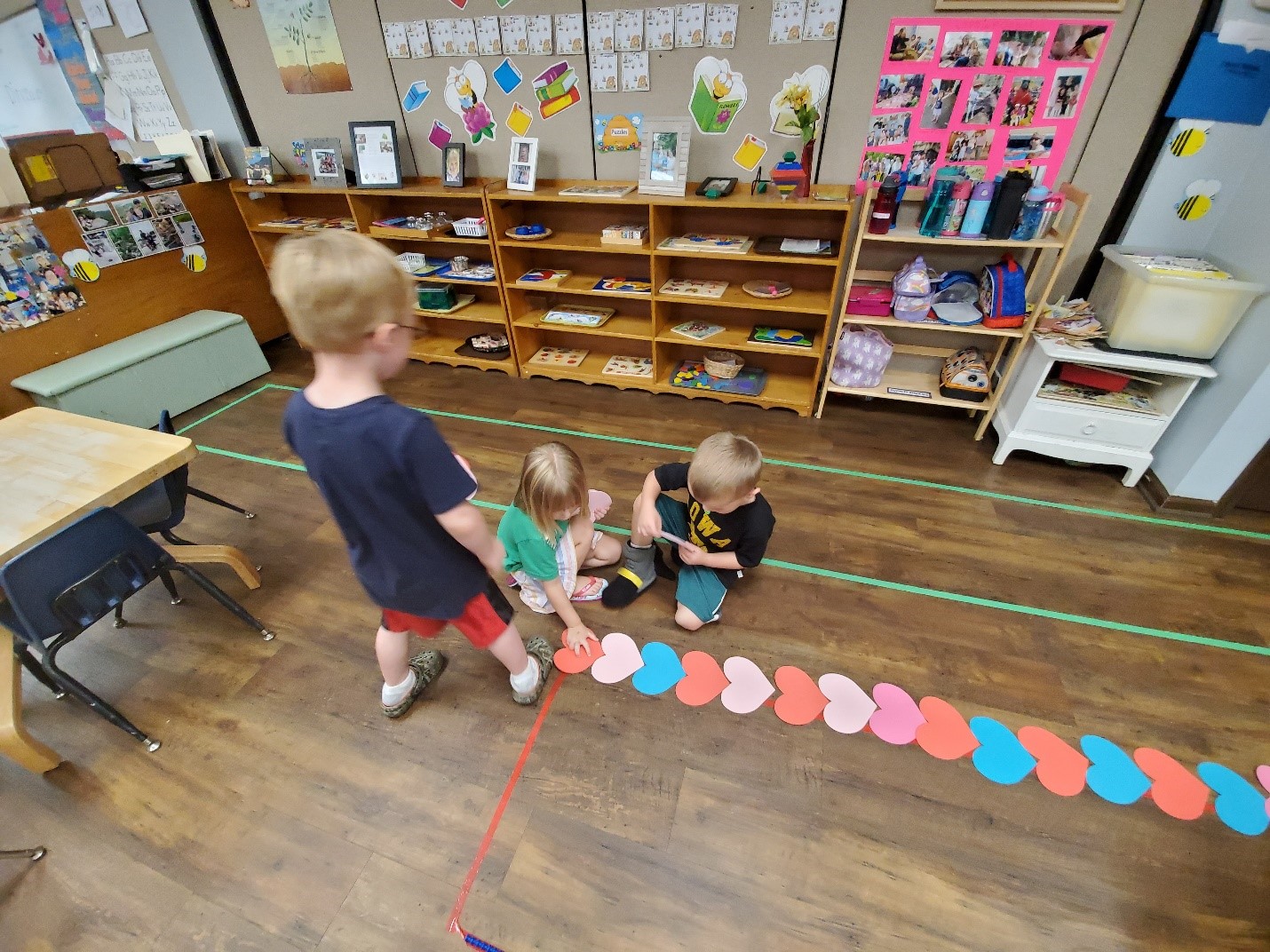
Day 2 Morning Session: Exploration
Before starting the activity (Figure 1), we talked to students about expectations for “using listening ears” and being careful about “hands and feet to ourselves” since we would not want any students to get kicked when lined up close to each other. In the classroom students wear slippers or “indoor shoes.” However, in a classroom where students are wearing hard-soled outdoor shoes we would suggest having students remove shoes for this part of the lesson. Learners lined up randomly along the perimeter of the class and were reminded of our research questions: How long were the dinosaurs from head to tail? How did they compare to us? Students made predictions about how many students would make up the length of each dinosaur. Students gave a variety of answers, but all were large numbers.
Dinosaur measuring activity.
Suggested Materials
- Five colors of masking tape
- Meterstick
- Plastic dinosaurs and/or photos of dinosaurs such as Triceratops, Stegosaurus, Pachycephalosaurus, Velociraptor, Microraptor, Compsognathus
- National Geographic Kids: Ultimate Dinopedia, 2nd Edition
- Large chart paper (two pieces)
- Dot stickers that come in various colors
- String (optional)
- Items that students can use for nonstandard measurement tools, such as: pipe cleaners, unsharpened pencils, magnet blocks (all one shape), thin-line markers, craft sticks, drinking straws, CDs, identical size and shape foam pieces, and plastic counting implements
Preparation
Five colors of masking tape and metersticks were used to measure lines on the floor of the classroom that represented the lengths of dinosaurs stated in the book National Geographic Kids: Ultimate Dinopedia, 2nd Edition (Lessem 2017). If students are present during setup, safety precautions should be taken with the metersticks.
The largest dinosaur that could be measured inside was the 12 meter Tyrannosaurus. Tape lines also included: 8 meters for the Triceratops and Stegosaurus, 4.5 meters for the Pachycephalosaurus, 2 meters for the Velociraptor, and 0.56 meters for the Microraptor. In other areas of the classroom, the process was repeated for 4.5 meter and 2 meter lines so there would be multiple stations for groups during the Elaboration section. A tape line was also made to represent Compsognathus (0.9 meters), which was used for the Evaluation section. Pictures of each dinosaur were printed and taped next to the corresponding line.
Learners were asked to lay down end to end on the tape lines. They needed some help to space out appropriately without leaving gaps. Lines were imperfect, as kids kept wiggling with excitement. Once a line was complete, they counted off to figure out how many students were equal to the length of a dinosaur. When students got up from the line, each was given a sticker to place on a piece of chart paper. Each sticker made part of the bar representing the number of students it took to equal the length of a specific dinosaur. We measured one line at a time to help students stay focused. Students rotated so they all got a chance to be part of one or two lines. They used mathematical and computational thinking as they compared the length of dinosaurs and displayed the data in bar graph format. This activity also gave students a chance to practice counting to identify patterns, such as how it took fewer students to equal the length of shorter dinosaurs and more students to equal the length of longer dinosaurs.
Accommodations should be made for students with special needs. Those with sensory processing disorders, who are in a wheelchair, or have limited mobility may not be able to lay down on the floor. For these students, the teacher could help make a piece of string the length of the student and the teacher and the student could hold the string in place to represent the height of the student.
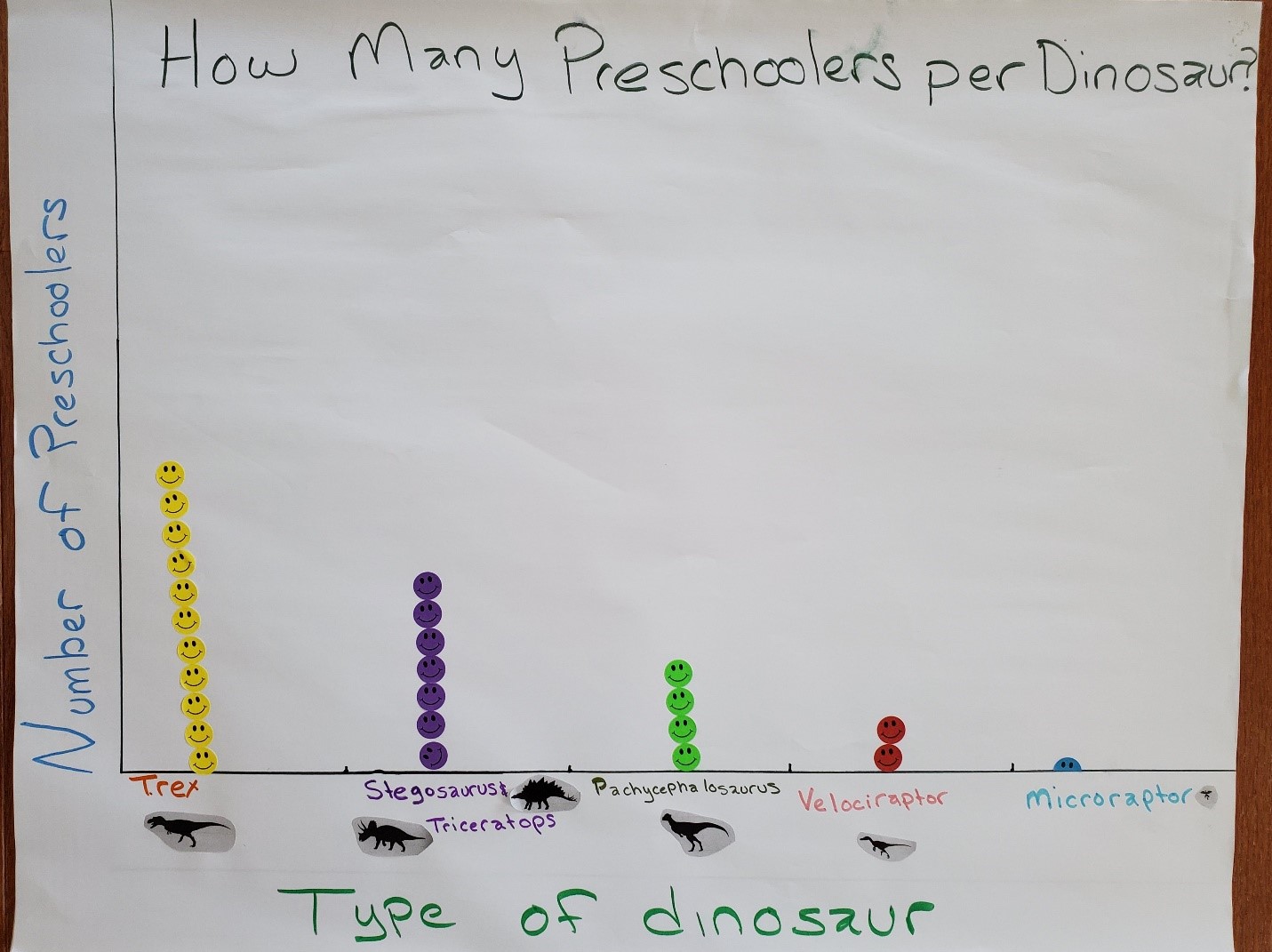
Day 2 Afternoon Session: Explanation
In circle time, the class used mathematical thinking to describe and make comparisons between the length of themselves and dinosaurs. Students worked to “describe and compare measurable attributes” such as comparing the length of dinosaurs to students (NGAC and CCSSO 2019). We then defined the word scale in basic terms of how large something is compared to something else. This lesson used scale in a spatial sense since students were comparing lengths. Students shared their experiences of using scale in the classroom, such as previous activities where students compared larger and smaller objects. The classroom has Montessori wooden sorting trays that are set up with various objects that students can sort throughout the year. We asked what things they have sorted into large, medium, and small. One of the boys stated he “likes picking up buttons and sorting them by big and small.” Another learner explained “the seashells come in different sizes and I can put them in different piles.” Students made the connection that scale related to sorting objects into big, medium, and small.
Students reviewed findings from the bar chart and then revisited the dinosaur sorting activity from the engagement section. We asked students if their ideas had changed. They were able to analyze and interpret the data and explain their reasoning with statements like “It took 11 kids to make the T. rex but only eight for the Triceratops, so the T. rex was bigger.” We reiterated the research question, which required students to analyze and interpret their data. We asked: How long were the dinosaurs from head to tail? How did their length compare to our height? A student explained “It’s all different. Some dinosaurs were super big, but one was smaller than me.” This suggests the activity was able to help reverse the common misconception that all dinosaurs were large.
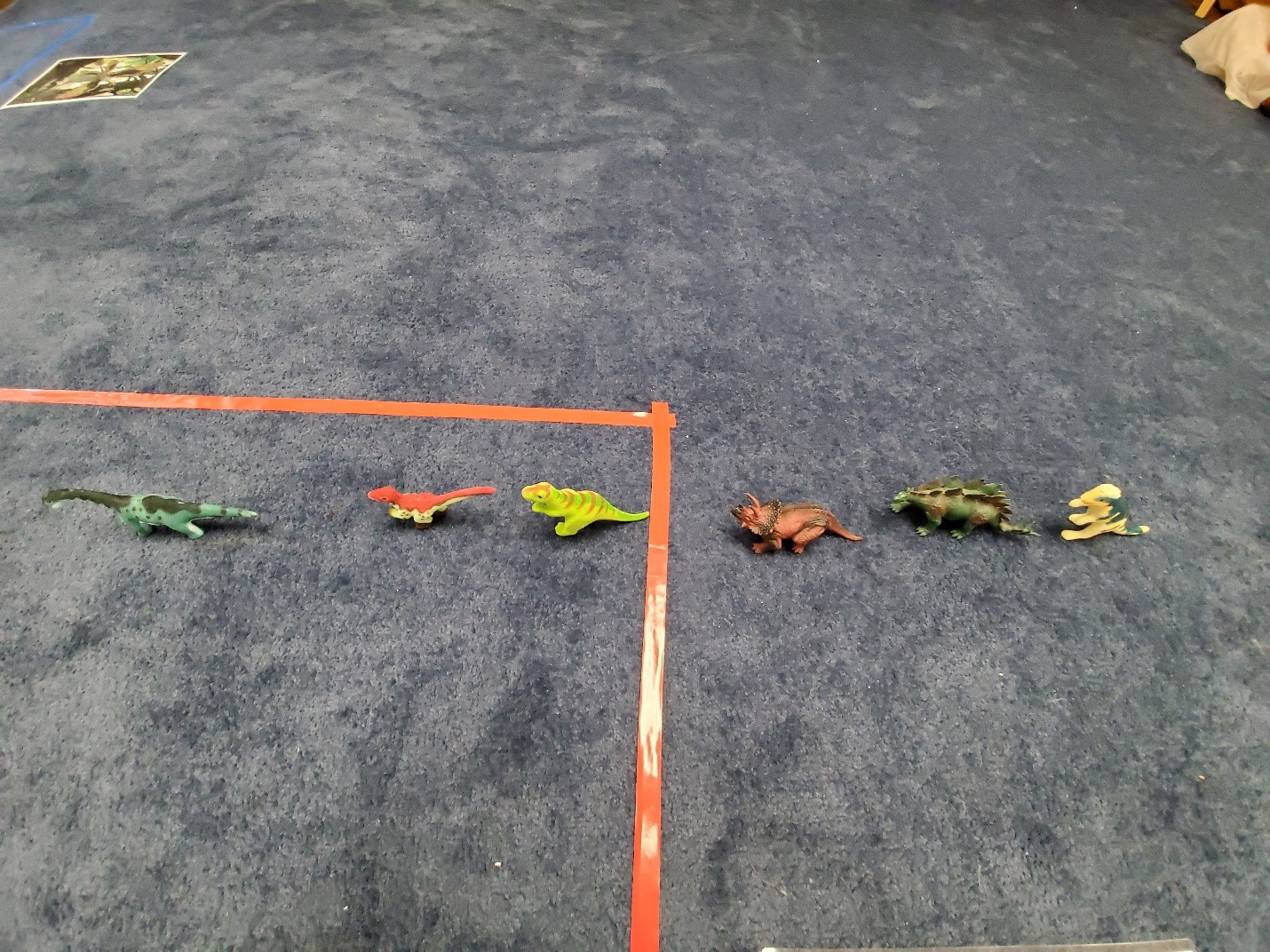
During this portion of the lesson, connections can be made to larger scientific concepts related to adaptation. Students were invited to ponder why some dinosaurs were enormous while others were much smaller. We asked, “Do you think the Apatosaurus was shorter or longer than the T. rex?” Students were conflicted on this as they knew the T. rex was the longest dinosaur they measured. We explained the Apatosaurus could grow up to 27 meters and would be too long to measure in our classroom. Students were amazed to learn that it was double the length of T. rex, or similar in length to our classroom and the next door classroom combined.
Sauropod dinosaurs like the Apatosaurus with their long necks, tiny head, and thick limbs captivate the imagination. An interesting feature of sauropod dinosaurs is their broad legs, which help to support their enormous bodies and may have been used to knock down trees (Holtz 2007). We asked students, “Can you think of any animals that are alive today that have thick limbs like the Apatosaurus?” Students shared their prior knowledge on animals like elephants and rhinos. Both are animals students had seen at the zoo or in books. Learners were able to connect the idea of thick limbs being able to support large bodies. We asked, “Can you think of any other animals that have thick legs like the elephant and rhino?” A student excitedly stated that “hippos are super big and need big legs.” Students also shared their ideas for why dinosaurs might have a long tail, sharp teeth, horns, and other adaptations and compared these ideas with what they knew about living animals. Being that dinosaur features are fascinating to young learners, this is an engaging way to have students start thinking about adaptations.
Day 3 Morning Session: Elaboration
We used the open-ended question: How long were the dinosaurs when compared to _______? Students got to select objects from around the classroom to use as nonstandard measurement tools to “optimize individual choice and autonomy” (CAST 2018). Objects that were made available included: pipe cleaners, unsharpened pencils, magnet blocks (all one shape), thin-line markers, craft sticks, drinking straws, CDs, identical size and shape foam pieces, and plastic counting implements. Items that all came in one length were purposefully selected.
Students were given the option to work independently or in small groups. Those who chose to work in groups were grouped based on ability level. Since our students’ counting abilities varied, we decided to limit the investigation to having all learners measure the length of two dinosaurs: 4.5 meter Pachycephalosaurs, and 2 meter Velociraptor. This allowed us to differentiate so that students who finished quickly were challenged to use their materials to measure the additional larger lines. Before starting the activity, we invited one student to come up and model how to place objects end to end on a tape line and model using one-to-one correspondence. After laying the objects down, the student demonstrated how to touch each object in the line as she counted it.
Students were assigned to different stations and we helped students rotate so they all got to measure both dinosaur length tape lines. An accommodation that could be made for students in wheelchairs or limited mobility would be to make additional tape lines across either classroom tables or counter spaces, so lines are more accessible.
Once groups made a measurement, they would line up to work with the assistant teacher who helped them place stickers to record their data on a second bar chart. One large chart was used as a way to have students practice counting and recording data. This was also a way to centralize data and look for patterns. Some learners needed additional support in counting their objects. Those that needed help could use the mathematics manipulatives like stackable cubes or were helped by one of us.
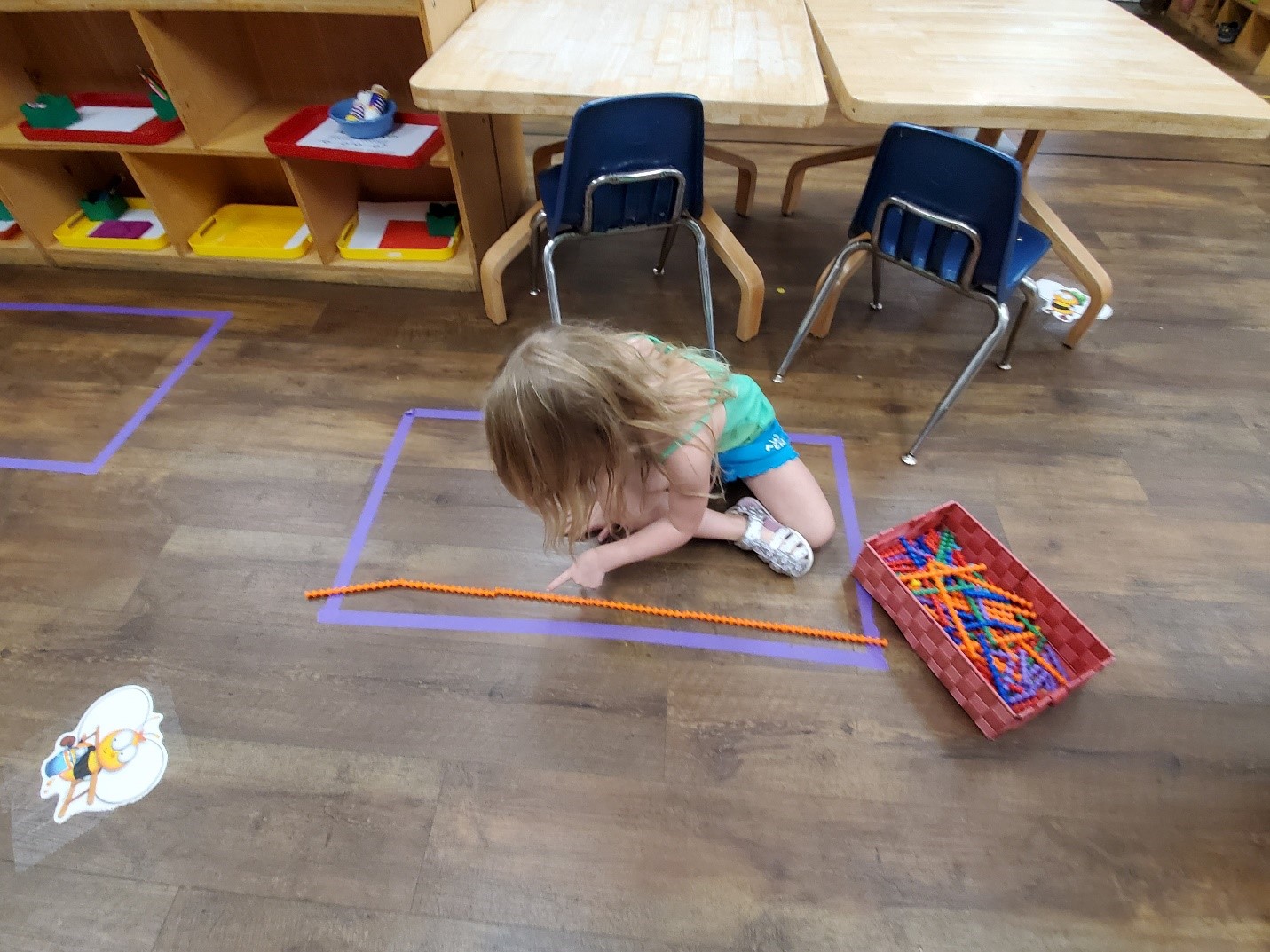
Day 3 Afternoon Session: Evaluation
In circle time, students discussed their findings while we examined the second bar chart. They analyzed and interpreted their data while they looked for patterns and used them as evidence. An example of a pattern explained by a student was, “I used popsicle sticks so I needed lots more than the markers.” We assisted students to “highlight patterns, critical features, big ideas, and relationships” (CAST 2018). They understood patterns such as that shorter dinosaurs needed fewer objects to measure them. One of our students put it into these terms: “We used lots of different stuff to measure dinosaurs and big dinosaurs needed more stuff.” One of our four-year-old students excitedly stated, “One of the dinosaurs was shorter than me and that one needed not many markers to measure, but the longer dinosaur needed more markers to measure.” They were all able to compare using relative scales by describing how long a specific dinosaur was in relation to students or an object like craft sticks. Their favorite fact was that “a T.rex was the length of 11 friends.” A student shared “today we used math and counting to do science and learn about dinosaurs” showing her understanding of the multidisciplinary nature of the lesson.
We posed an additional problem as a summative evaluation. A new dinosaur was discovered in the classroom, the Compsognathus (0.9 meters) and we needed to compare the length to the Velociraptor. Students were shown a new tape line and asked to make a prediction of whether it would take more or less of their item to measure the Compsognathus compared to the Velociraptor. Each learner was evaluated independently and was allowed to measure using objects of choice. Many students understood they needed to use the same object as before to make comparisons. A few students selected new objects and we let them measure and then guided them with questions until they realized they would have to measure the other dinosaur tape lines with the same object to make comparisons.
Concluding Remarks
This 5E lesson was an engaging way to use three-dimensional learning with young students. The lesson took us multiple days and could easily take four to five days of classroom instruction. Tape lines were left on the floor for many days following the completion of this lesson. Students used free-choice time to continue practicing nonstandard measurement and counting. The learners showed continual interest in viewing the drawings of dinosaurs in books and comparing similarities and differences. Our learners’ enduring enthusiasm is why we believe these strategies are effective for three-dimensional learning. Though we designed the lesson using dinosaurs, the methods described could easily be transferred to any topic of interest to students. ●
We would like to thank Kimberly Jordan, Instructional Resource Teacher at Hollywood Elementary in Hollywood, Maryland, for her insights on how to make this lesson inclusive for all learners.
Laura B. Schneider (laurabethschneider213@gmail.com) is an adjunct professor in the Environmental Studies Program at St. Mary’s College of Maryland in St. Mary’s City, Maryland, and a high school teacher at Great Mills High School in Great Mills, Maryland. Angelique Kelly is a primary-level teacher at Starmaker School for Early Education in California, Maryland.
5E Earth & Space Science Pedagogy Three-Dimensional Learning Elementary


